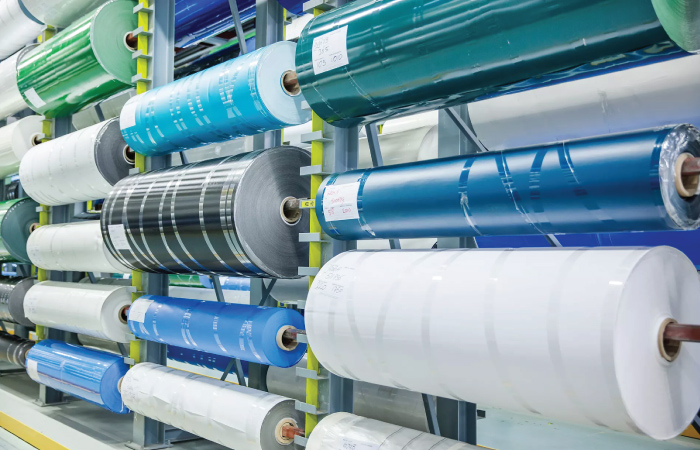
Coating Materials
The coatings used on Synthetic Belts are called polymers and can be made of various materials which have influence on the suitability of the belt in a certain application.
Polymers can be separated into two different groups : thermoplastic or thermoset.
Mainly used compounds for coatings are :
PVC | Polyurethane | Polyolefin | Polyester
PVC
Polyvinyl chloride, commonly abbreviated to PVC, is a widely produced plastic. PVC is a type of thermoplastic polymer that is flexible and durable, and therefore suitable for use on conveyor systems.
Main PVC coating types:
Flexam
Product features:
- Good chemical resistance (including chlorine)
- Hydrolysis resistance (hot water and steam)
- Flame-retardant types available (ISO 340)
- Some food types available (dry food)
- Economically priced
- Available in many different hardnesses, profiles and colours
Industries:
- Airports
- Logistics
- Agriculture
- Fruit and Vegetables
- Marble and Ceramic
Nonex
Product features:
- Good resistance to oil and fat
- Food compliance for all foodstuff
- Available in white and light blue, and with different profiles
Industries:
- Food
- Handling unpacked food
Arcon
Product features:
- Abrasion Resistant (ISO 5470-1)
- Compliance with EC and FDA
- Flame retardant (ISO 340)
- ATEX cat. 2 approved
- Anti-static (ISO 21178)
- Low elongation
- Possible with sealed edges
- Lightweight constructions
Typical application:
- Transport of refined sugar or other
granular products - Trough, horizontal or inclined
conveyors - Bucket elevators
Polyurethane
Polyurethane belts are mainly used in the Food Industry. Due to its structure, polyurethane belts do not give off damaging toxins or chemicals. Polyurethanes for process and conveyor belting can be either thermoplastic – TPU, or thermoset – PUR. Thermoplastic polyurethane coating material excels through its exceptional resistance to grease, oils and chemicals.
Main polyurethane coating types:
Ropanyl
Product features:
- Belts with thermoplastic polyurethane coating
- Very flexible even at low temperatures
- Very good resistance to oil and fat
- Good abrasion resistance
- Food compliance for all foodstuff
- Available in many colours, and with profiles
- Ropanyl Premium Plus = Non-fray
Industries:
- Food
- Packaging
- Wood
- Textile
- Metal
Dectyl
Product features:
- Metal Detectable
- Belts with thermoplastic coating
- Very flexible even at low temperatures
- Very good resistance to oil and fat
- Good abrasion resistance
- Food compliance for all foodstuff
- Available in matt finish and glossy
Industries:
- Food
- Tyre
- Wood
Ropanol
Product features:
- Belts with polyurethane impregnation (zero thickness)
- Low friction top side for accumulation
- Very flexible even at low temperatures
- Good abrasion resistance
- Food compliance for all foodstuff
- Available in different colours
Industries:
- Food
- Logistics
- Airport
- Electronics
Ropan
Product features:
- Belts with unique heavy duty polyurethane coating
- Extremely good abrasion and cut resistance
- Thermoplastic inner layer, suitable for hot splicing
- Available in white colour
Industries:
- Metal
- Building Materials (bricks)
Polyolefin & Polyester
Polyolefins are the largest group of thermoplastics; they are polymers of simple olefins such as ethylene. Polyethylene is probably the polymer you see most in daily life; it is the most popular plastic in the world.
Main polyethylene coating types are:
Peflex
Product features:
- Flexible at low temperatures
- Chemically inert material, good chemical resistance
- Pyrolysis resistance (non-toxic when burning, tobacco approved)
- Food compliance
- Easy release properties
- Wide range of types available, with different profiles
Industries:
- Tobacco
Poliflex
Product features:
- Excellent chemical resistance
- Pyrolysis resistance (non-toxic when burning, tobacco approved)
- Food compliance for all foodstuffs
- Very good release of sticky products
- Special types available for small pulley transfer points
Industries:
- Tobacco
- Food
Polikleen
Product features:
- Excellent chemical resistance
- Pyrolysis resistance (non-toxic when burning, tobacco approved)
- Good wear resistance
- Very easy to clean
Industries:
- Tobacco
- Wood (lacquering)
Amtel
Product features:
- Polyester
- Mechanically very strong
- Flexible at low temperatures
- Good hydrolysis resistance
- Pyrolysis resistance (non-toxic when burning, tobacco approved)
- Good abrasion and cut resistance
Industries:
- Tobacco
- Food
Fabric & Felt
Fabric and Felt belts are used in a wide variety of material transport applications such as car manufacturing, food processing and heavy industry. Felt is a non-woven fabric. The most important raw material for belting fabrics is polyester.
Main fabrics used:
- Cotton (natural)
- Flax (natural)
- Polyamide (synthetic)
- Polyester (synthetic)
Specials
By mixing polymers together, Ammeraal Beltech produces variations on PVC or PU called “Special Blends”. E.g.:
- Pletex (red): a special thermoplastic low hardness polyblend for high grip applications
- Elastoflex: a rubber / PVC compound which combines the excellent mechanical properties of PVC with the wear resistant characteristics of rubber
- Elastonyl: a rubber / TPU compound which combines the excellent mechanical properties of TPU with the wear resistant characteristics of rubber
- Ultraclean: a special compound of TPU with a high tech polymer with superior release properties
Silam
Product features:
- Good release of sticky products
- High temperature resistance
- Chemical resistance
Industries:
- Food
- Tyre
Pletex
Product features:
- High grip
- Good chemical resistance
- Available in red colour
Industries:
- Paper and Print
Elastoflex
Product features:
- Very good wear resistance and good grip
- Good oil resistance
- Available in green and beige colour
Industries:
- Paper and Print
- Wood
Elastonyl
Product features:
- Excellent wear-resistance and good grip
- Very good oil resistance
- Available in green colour
Industries:
- Paper and Print
Ultraclean
Product features:
- Excellent release properties
- Very good oil and fat resistance
- High chemical resistance
Industries:
- Food (sticky products)
Ultranyl
Product features:
- Very good hydrolysis resistance
- Good oil and fat resistance
- Flexible, suitable for high temperature
Industries:
- Food
